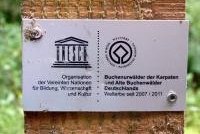
When choosing which of the 5 German Beech forests to visit we looked for one which was reasonably close to our main route for other WHS and gave us the chance definitely to enter the inscribed area with a hike of 1-2 hours from a roadhead. It came down to 2 – Hainich which is north of Eisenach and therefore convenient for a visit to the Wartburg and Kellerwald-Edersee which is west of Kassel and therefore convenient for a visit to the Bergpark.
It is worth noting that in the case of all 5 WHS inscriptions the inscribed area is significantly smaller than the National Park or Reserve within which they are situated. The inscribed area will have been chosen because it contains the most significant primary growth forest - inevitably that tends to put it in the centre of the Park/Reserve which will also encompass secondary growth areas which will probably contain areas of modern re-planting or re-growth.
We homed in on Kellerwald-Edersee where its northern inscribed boundary is, for a kilometer or so, contiguous with that of the NP at the point where it flanks the Edersee itself. On the drive in it is possible to pick up a reasonably detailed map of the NP at Information Centres - perfectly adequate for a hike following a named trail. The UNESCO inscribed area is clearly differentiated from the NP on this map by green “hatching”. Some German road maps show a “white” road going all the way along the southern side of the Edersee through the inscribed area but this is only a rough path and not open to motor vehicles. The village of Bringhausen is about 10kms west of Edertal and beyond at the park boundary is a (free) parking area titled “Kirchweg”. Here we set out on the “Bloßenberg Route”. See map here http://www.nationalpark-kellerwald-edersee.de/de/naturerleben/wandern/blossenbergroute/
Taking it in a clockwise direction you need to leave it at the bottom where the lake arm reaches in and then cross the bridge going west. But you are still not in the inscribed area!! You need to follow the path towards Asel Sud along the banks of the Edersee and, at some (unmarked) point will enter the WHS. However, as we had copies of both the Nomination File and the Information Centre maps we felt able to strike inland and uphill at the bridge so as to make a circuit coming back along the shore and thus get into a “wilder” part of the forest. We eventually made our way back down to the lake approximately where the Western end of the inscribed area should have been – but we had still not seen ANY “proof” in the form of notice boards, logos etc that we had actually entered the inscribed area! The frequent notice boards both at the car park and along the route describing land form, flora and fauna were liberally covered with logos for numerous ministries and programs but the UNESCO one was notablye absent! This is possibly due to the fact that the NP was created in 2004 and all the signage was completed then – whereas UNESCO inscription only came in 2011. But it isn’t like Germany not to, very visibly, “celebrate” Welterbe status - even if it did mean redoing all the signs! As another attempt we set off further towards Asel Sud than we had intended in order to scout the western boundary and there it was – in the undergrowth, where the path crossed a stream, a small post with an even smaller metal tag screwed to it displaying UNESCO and WH logos! (photo).
Apart from the “proven” success of entering the inscribed area, what else did we gain from our c 2 hour hike (we could by the way easily have continued to Asel where food and drink is available). The path along the Edersee is quite busy with cyclists and is set up for park ranger 4 x4s so I would certainly recommend going inland. There we found some very pleasant quiet mossy glades with vast numbers of fungi and glorious vistas through the trees in the dappled sunlight. We didn’t see any mammals but did get nice views of Great Crested Grebe on the Edersee and, for us, the star sight of an Osprey swooping to catch a fish – a sight we have tried to see on many occasions without success in Africa and Scotland!
More on
Comments
No comments yet.
